Assessment of Indoor Air Quality in Residential Buildings of New England through Actual Data
Abstract
:1. Introduction
2. Materials and Methods
2.1. Analysis of the Case Studies
2.2. Monitoring
2.3. Exterior Ambient Quality
2.4. Blower Door Test
3. Results
3.1. Blower Door Test Results and Ventilation Requirements
3.2. Temperature and CO2 Concentration Analysis
3.3. PM2.5 and TVOC Concentration Analysis
4. Discussion
4.1. Correlation Matrix
4.2. Weekly Analysis
4.3. Daily Analysis
5. Conclusions
Author Contributions
Funding
Institutional Review Board Statement
Informed Consent Statement
Data Availability Statement
Acknowledgments
Conflicts of Interest
References
- Shrubsole, C.; Dimitroulopoulou, S.; Foxall, K.; Gadeberg, B.; Doutsi, A. IAQ guidelines for selected volatile organic compounds (VOCs) in the UK. Build. Environ. 2019, 165, 106382. [Google Scholar] [CrossRef]
- USEPA. Indoor Air Quality. Available online: https://www.epa.gov/report-environment/indoor-air-quality (accessed on 20 October 2021).
- Kim, J.; Hong, T.; Kong, M.; Jeong, K. Building occupants’ psycho-physiological response to indoor climate and CO2 concentration changes in office buildings. Build. Environ. 2020, 169, 106596. [Google Scholar] [CrossRef]
- Leivo, V.; Mari Turunen, M.; Aaltonen, A.; Kiviste, M.; Du, L.; Haverinen-Shaughnessy, U. Impacts of Energy Retrofits on Ventilation Rates, CO2-levels and Occupants’ Satisfaction with Indoor Air Quality. Energy Procedia 2016, 96, 260–265. [Google Scholar] [CrossRef] [Green Version]
- Shriram, S.; Ramamurthy, K.; Ramakrishnan, S. Effect of occupant-induced indoor CO2 concentration and bioeffluents on human physiology using a spirometric test. Build. Environ. 2019, 149, 58–67. [Google Scholar] [CrossRef]
- Kubečková, D.; Kraus, M.; Šenitková, I.J.; Vrbová, M. The Indoor Microclimate of Prefabricated Buildings for Housing: Interaction of Environmental and Construction Measures. Sustainability 2020, 12, 10119. [Google Scholar] [CrossRef]
- McGill, G.; Oyedele, L.O.; McAllister, K. Case study investigation of indoor air quality in mechanically ventilated and naturally ventilated UK social housing. Int. J. Sustain. Built Environ. 2015, 4, 58–77. [Google Scholar] [CrossRef] [Green Version]
- Merabtine, A.; Maalouf, C.; Al Waheed Hawila, A.; Martaj, N.; Polidori, G. Building energy audit, thermal comfort, and IAQ assessment of a school building: A case study. Build. Environ. 2018, 145, 62–76. [Google Scholar] [CrossRef]
- Fernández-Agüera, J.; Dominguez-Amarillo, S.; Fornaciari, M.; Orlandi, F. TVOCs and PM 2.5 in Naturally Ventilated Homes: Three Case Studies in a Mild Climate. Sustainability 2019, 11, 6225. [Google Scholar] [CrossRef] [Green Version]
- McGill, G.; Oyedele, L.O.; McAllister, K.; Qin, M. Effective indoor air quality for energy-efficient homes: A comparison of UK rating systems. Archit. Sci. Rev. 2016, 59, 159–173. [Google Scholar] [CrossRef]
- Hormigos-Jimenez, S.; Padilla-Marcos, M.Á.; Meiss, A.; Gonzalez-Lezcano, R.A.; Feijó-Muñoz, J. Ventilation rate determination method for residential buildings according to TVOC emissions from building materials. Build. Environ. 2017, 123, 555–563. [Google Scholar] [CrossRef]
- Vardoulakis, S.; Dimitroulopoulou, C.; Thornes, J.; Lai, K.-M.; Taylor, J.; Myers, I.; Heaviside, C.; Mavrogianni, A.; Shrubsole, C.; Chalabi, Z.; et al. Impact of climate change on the domestic indoor environment and associated health risks in the UK. Environ. Int. 2015, 85, 299–313. [Google Scholar] [CrossRef] [Green Version]
- Yang, X.D.; Srebric, J.; Li, X.T.; He, G.Q. Performance of three air distribution systems in VOC removal from an area source. Build. Environ. 2004, 39, 1289–1299. [Google Scholar] [CrossRef]
- Dominguez, S.; Fernandez-Aguera, J.; Cesteros-García, S.; Gonzalez-Lezcano, R. Bad Air Can Also Kill: Residential Indoor Air Quality and Pollutant Exposure Risk during the COVID-19 Crisis. Int. J. Environ. Res. Public Health 2020, 17, 7183. [Google Scholar] [CrossRef]
- Domínguez-Amarillo, S.; Fernández-Agüera, J.; Sendra, J.J.; Roaf, S. Rethinking User Behaviour Comfort Patterns in the South of Spain—What Users Really Do. Sustainability 2018, 10, 4448. [Google Scholar] [CrossRef] [Green Version]
- Widder, S.H.; Haselbach, L. Relationship among Concentrations of Indoor Air Contaminants, Their Sources, and Different Mitigation Strategies on Indoor Air Quality. Sustainability 2017, 9, 1149. [Google Scholar] [CrossRef] [Green Version]
- Duro, A.; Piccione, V.; Ragusa, M.A.; Veneziano, V. New Enviromentally Sensitive Patch Index-ESPI-for MEDALUS protocol. AIP Conf. Proc. 2014, 1637, 305–312. [Google Scholar]
- Paoli, L.; Maccelli, C.; Guarnieri, M.; Vannini, A.; Loppi, S. Lichens “travelling” insmokers’ cars are suitable biomonitors of indoor air quality. Ecol. Indic. 2019, 103, 576–580. [Google Scholar] [CrossRef]
- Carlos, J.S.; Silva, P.D.; Corvacho, H.; Gomes, J.P.C. Pré-aquecimento do ar de Ventilação: Recomendações para estratégias bioclimáticas. Eng. Civ. 2010, 38, 45–56. [Google Scholar]
- Liddament, M.W.; Orme, M. Energy and ventilation. Appl. Therm. Eng. 1998, 18, 1101–1109. [Google Scholar] [CrossRef]
- Guyot, G.; Sherman, M.H.; Walker, I.S. Smart ventilation energy and indoor air quality performance in residential buildings: A review. Energy Build. 2018, 165, 416–430. [Google Scholar] [CrossRef] [Green Version]
- Cardoso, V.E.M.; Pereira, P.F.; Ramos, N.M.M.; Almeida, R.M.S.F. The Impacts of Air Leakage Paths and Airtightness Levels on Air Change Rates. Buildings 2020, 10, 55. [Google Scholar] [CrossRef] [Green Version]
- Diaz Lozano Patino, E.; Siegel, J.A. Indoor environmental quality in social housing: A literature review. Build. Environ. 2018, 131, 231–241. [Google Scholar] [CrossRef]
- Hesaraki, A.; Myhren, J.A.; Holmberg, S. Influence of different ventilation levels on indoor air quality and energy savings: A case study of a single-family house. Sustain. Cities Soc. 2015, 19, 165–172. [Google Scholar] [CrossRef]
- Dales, R.; Liu, L.; Wheeler, A.J.; Gilbert, N.L. Quality of indoor residential air and health. Can. Med. Assoc. J. 2008, 179, 147–152. [Google Scholar] [CrossRef] [PubMed] [Green Version]
- Blanquet du Chayla, C.; Blanchet, P.; Lehoux, N. A Method to Qualify the Impacts of Certifications for Prefabricated Constructions. Buildings 2021, 11, 331. [Google Scholar] [CrossRef]
- Mc Carron, B.; Meng, X.; Colclough, S. An Investigation into Indoor Radon Concentrations in Certified Passive House Homes. Int. J. Environ. Res. Public Health 2020, 17, 4149. [Google Scholar] [CrossRef]
- U.S. Climate Data. Available online: https://www.usclimatedata.com/ (accessed on 10 November 2021).
- Lu, N.; Liska, R.W. Designers’ and general contractors’ perceptions of offsite construction techniques in the United States construction industry. Int. J. Constr. Educ. Res. 2008, 4, 177–188. [Google Scholar] [CrossRef]
- ISO 23210; Stationary Source Emissions—Determination of PM10/PM2,5 Mass Concentration in Flue Gas—Measurement at Low Concentrations by Use of Impactors. International Organization for Standardization: Geneva, Switzerland, 2009.
- Kozákovác, J.; Leoni, C.; Klán, M.; Hovorka, J.; Racek, M.; Kostejn, M.; Ondrácek, J.; Moravec, P.; Schwarz, J. Chemical Characterization of PM1-2.5 and its Associations with PM1, PM2.5-10 and Meteorology in Urban and Suburban Environments. Aerosol Air Qual. Res. 2018, 18, 1684–1697. [Google Scholar] [CrossRef] [Green Version]
- Gotschi, T.; Oglesby, L.; Mathys, P.; Monn, C.; Manalis, N.; Koistinen, K.; Jantunen, M.; Hanninen, O.; Polanska, L.; Kunzli, N. Comparison of black smoke and PM2.5 levels in indoor and outdoor environments of four European cities. Environ. Sci. Technol. 2002, 36, 1191–1197. [Google Scholar] [CrossRef]
- Prignon, M.; Van Moeseke, G. Factors influencing airtightness and airtightness predictive models: A literature review. Energy Build. 2017, 146, 87–97. [Google Scholar] [CrossRef]
- ASHRAE Standard 62.2; Ventilation and Acceptable Indoor Air Quality in Low-Rise Residential Buildings. ASHRAE: Atlanta, GA, USA, 2016.
- Russell, M.L.; Sherman, M.H.; Rudd, A. Review of Residential Ventilation Technologies. Hvac&r Res. 2007, 13, 325–348. [Google Scholar] [CrossRef]
- ASTM D6245-18; Standard Guide for Using Indoor Carbon Dioxide Concentrations to Evaluate Indoor Air Quality and Ventilation. ASTM: West Conshohocken, PA, USA, 2018.
- Derbez, M.; Berthineau, B.; Cochet, V.; Lethrosne, M.; Pignon, C.; Ribéron, J.; Kirchner, S. Indoor air quality and comfort in seven newly built, energy-efficient houses in France. Build. Environ. 2014, 72, 173–187. [Google Scholar] [CrossRef]
- Saini, J.; Dutta, M.; Marques, G. A comprehensive review on indoor air quality monitoring systems for enhanced public health. Sustain. Environ. Res. 2020, 30, 6. [Google Scholar] [CrossRef] [Green Version]
- Moreno-Rangel, A.; Sharpe, T.; Musau, F.; McGill, G. Field evaluation of a low-cost indoor air quality monitor to quantify exposure to pollutants in residential environments. J. Sens. Sens. Syst. 2018, 7, 73–88. [Google Scholar] [CrossRef] [Green Version]
- Air Quality Index (AQI) by City. Available online: https://www.airnow.gov/?city=Keene&state=NH&country=USA (accessed on 15 November 2021).
- Meiss, A.; Feijó-Muñoz, J. The energy impact of infiltration: A study on buildings located in north central Spain. Energy Effic. 2015, 8, 51–64. [Google Scholar] [CrossRef]
- Liddament, M.W. A Guide to Energy Efficient Ventilation; Air Infiltration Vent; AIVC: Brussels, Belgium, 1996. [Google Scholar]
- ASHRAE Standard 90.2; Energy-Efficient Design of Low-Rise Residential Buildings. ASHRAE: Atlanta, GA, USA, 2016.
- Penney, D.; Benignus, V.; Kephalopoulos, S.; Kotzias, D.; Kleinman, M.; Verrier, A. Guidelines for Indoor Air Quality; National Institutes for Health: Bethesda, MD, USA, 2010.
- Global Air Pollution and Health—Technical Advisory Group. Available online: https://www.who.int/groups/global-air-pollution-and-health---technical-advisory-group (accessed on 15 November 2021).



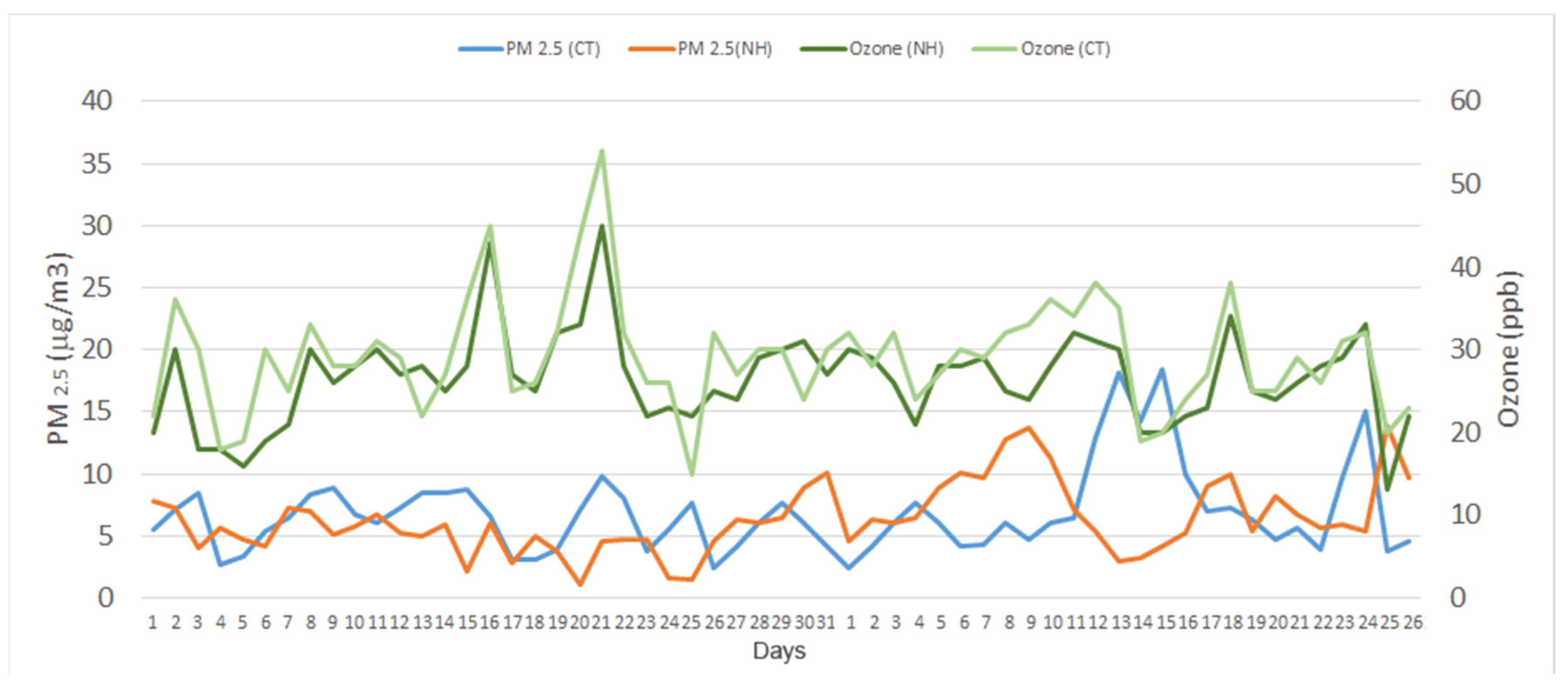

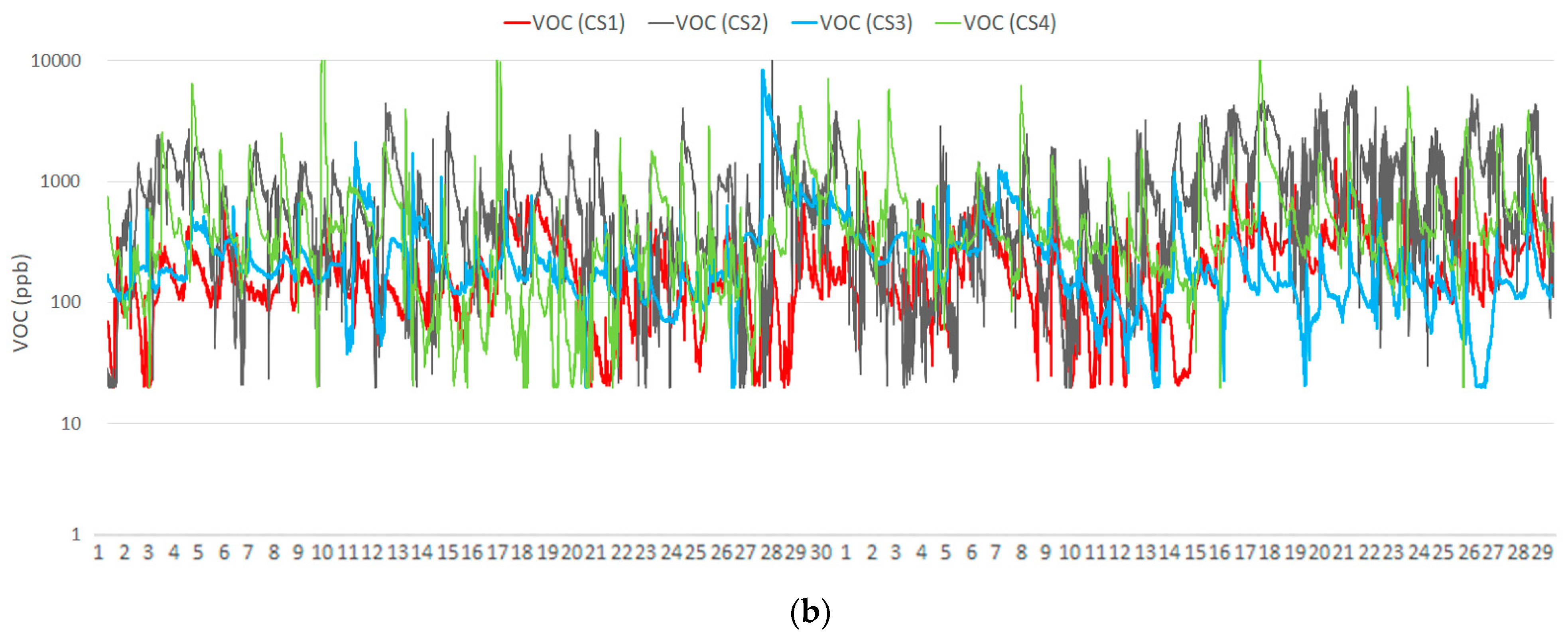
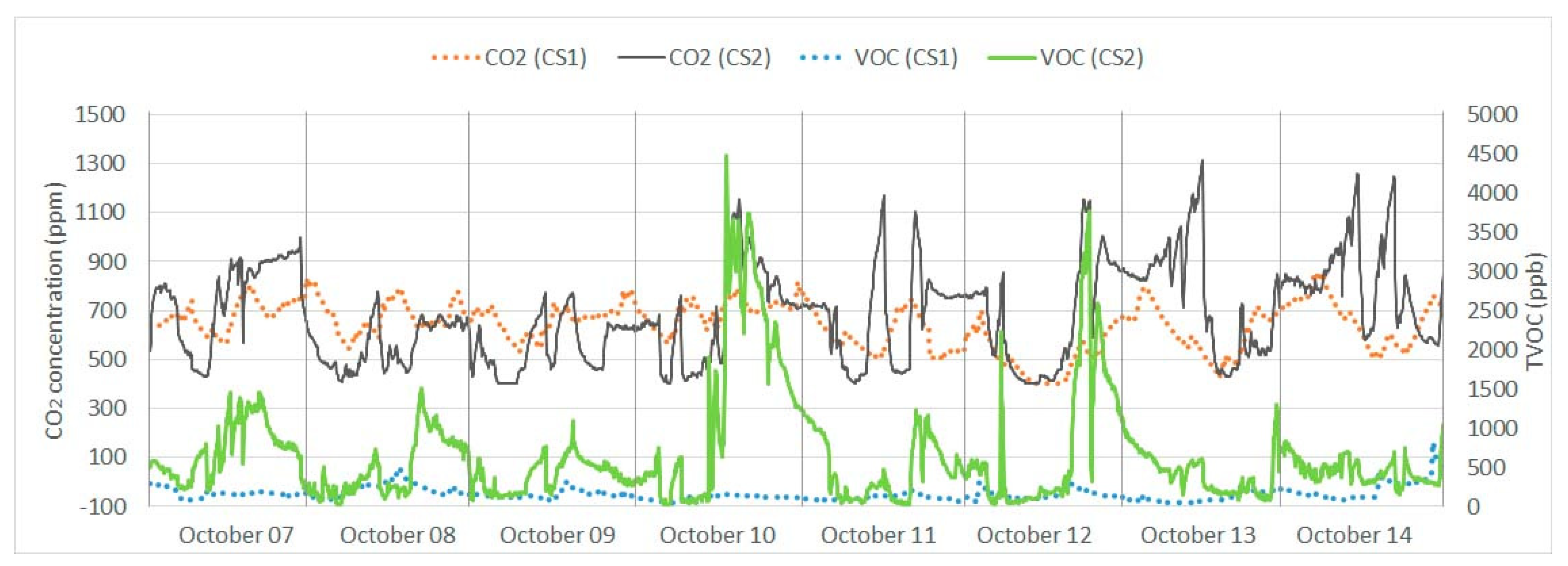
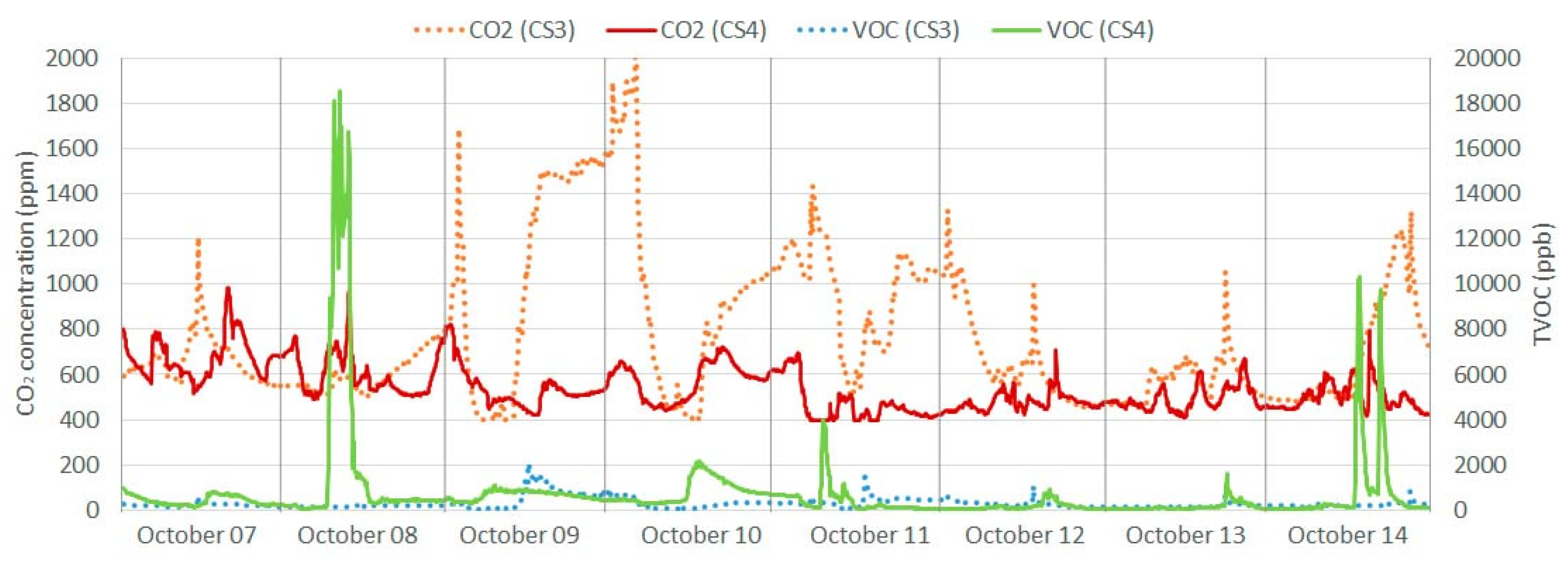
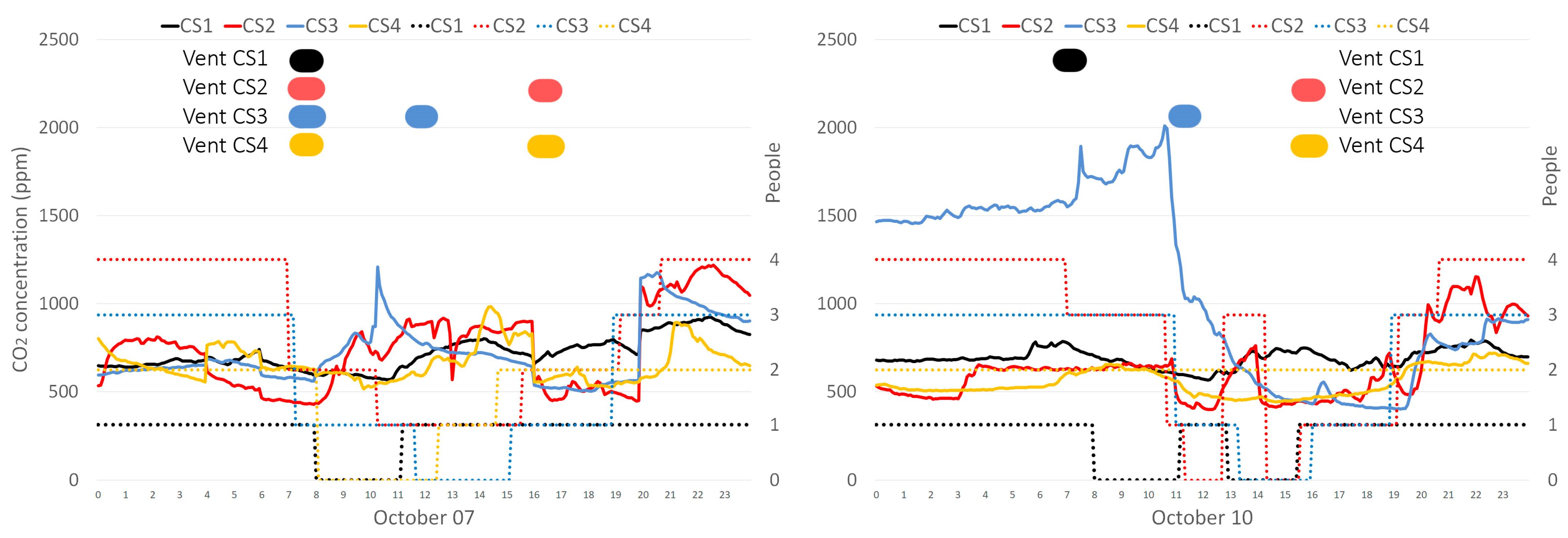
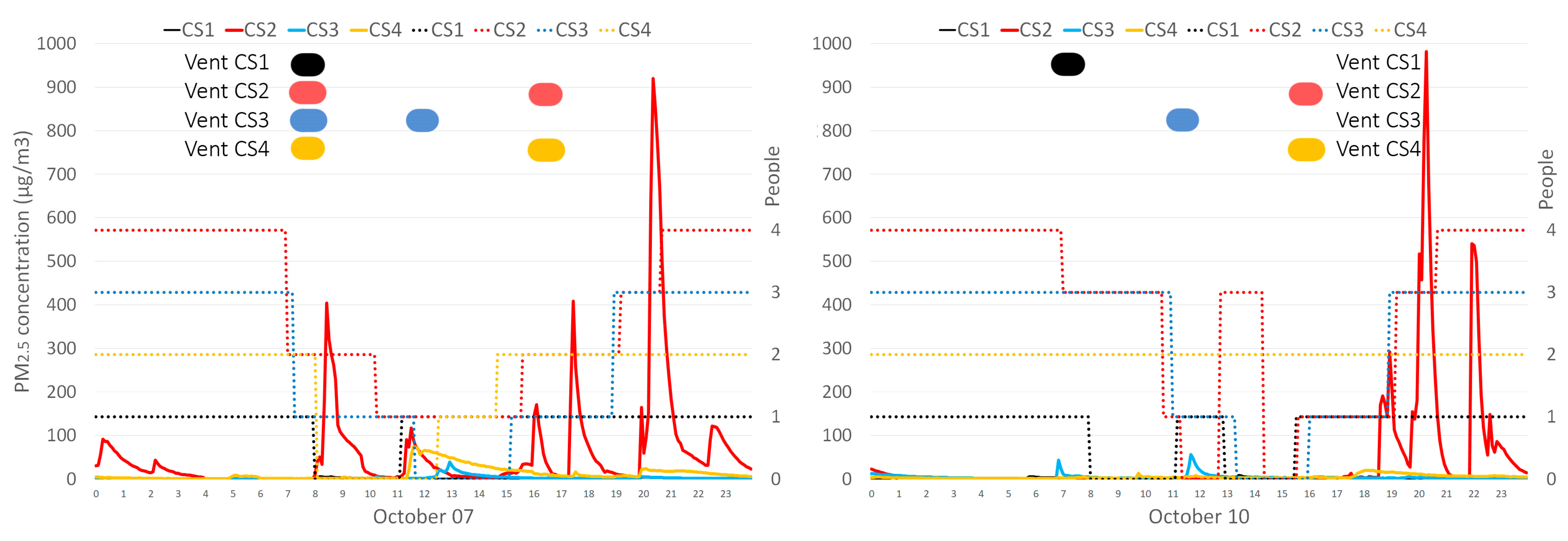

| Case Study | CS1 | CS2 | CS3 | CS4 |
|---|---|---|---|---|
| Construction year | 1995 | 1890 | 1955 | 1979 |
| Number of occupants | 1 | 4 | 3 | 2 |
| Smokers | No | Yes | Yes | No |
| Pets | No | No | Yes | No |
| Floor area (m2) | 79 | 210 | 120 | 164 |
| Indoor volume (m3) | 281 | 656 | 381 | 418 |
| Height (m) | 2.62 | 5.6 | 3.8 | 4.5 |
| Window area (m2) | ||||
| DHW system | Electric | Gas | Gas | Gas |
| Heating system | Gas furnace and air ducts | Gas furnace and air ducts | Gas furnace and air ducts | Gas boiler and radiators |
| Cooling system | No | No | Heat pump and air ducts | No |
| Ventilation system | Natural ventilation operable windows | Natural ventilation operable windows | Natural ventilation operable windows | Natural ventilation operable windows |
| Stove or fireplace | No | No | Yes | Yes |
| Carpets | No | Yes | No | |
| House Typology | Single family | Single family | Single family | Single family |
| Floors | 1 | 2 + basement | 2 | 2 + basement |
| Facades exposed to the wind | 4 | 4 | 4 | 4 |
| Case Study | Volume (m3) | Nbr | ACH50 | Q50 (L/s) | wsf | H/Hr | Qtot (L/s) | Qinf (L/s) | Qfan (L/s) |
|---|---|---|---|---|---|---|---|---|---|
| CS1 | 281 | 2 | 5.21 | 408 | 0.51 | 1.04 | 22 | 11 | 17 |
| CS2 | 656 | 4 | 8.04 | 1465 | 0.51 | 1.22 | 49 | 42 | 13 |
| CS3 | 381 | 3 | 5.54 | 587 | 0.50 | 2.23 | 29 | 21 | 13 |
| CS4 | 418 | 2 | 1.71 | 199 | 0.50 | 1.60 | 35 | 6 | 34 |
| (CS1) | (CS2) | (CS3) | (CS4) | |
|---|---|---|---|---|
| PM2.5 (IN)/PM2.5 (OUT) | 0.143 | 0.470 | 0.157 | 0.020 |
| Ti/CO2 | 0.418 | 0.122 | 0.417 | 0.256 |
| VOC/CO2 | 0.303 | 0.542 | 0.456 | 0.294 |
| PM2.5 (IN)/VOC | 0.037 | 0.062 | 0.226 | 0.480 |
| PM2.5 (IN)/CO2 | 0.074 | 0.097 | 0.226 | 0.069 |
Publisher’s Note: MDPI stays neutral with regard to jurisdictional claims in published maps and institutional affiliations. |
© 2022 by the authors. Licensee MDPI, Basel, Switzerland. This article is an open access article distributed under the terms and conditions of the Creative Commons Attribution (CC BY) license (https://creativecommons.org/licenses/by/4.0/).
Share and Cite
Gonzalo, F.d.A.; Griffin, M.; Laskosky, J.; Yost, P.; González-Lezcano, R.A. Assessment of Indoor Air Quality in Residential Buildings of New England through Actual Data. Sustainability 2022, 14, 739. https://doi.org/10.3390/su14020739
Gonzalo FdA, Griffin M, Laskosky J, Yost P, González-Lezcano RA. Assessment of Indoor Air Quality in Residential Buildings of New England through Actual Data. Sustainability. 2022; 14(2):739. https://doi.org/10.3390/su14020739
Chicago/Turabian StyleGonzalo, Fernando del Ama, Matthew Griffin, Jacob Laskosky, Peter Yost, and Roberto Alonso González-Lezcano. 2022. "Assessment of Indoor Air Quality in Residential Buildings of New England through Actual Data" Sustainability 14, no. 2: 739. https://doi.org/10.3390/su14020739
APA StyleGonzalo, F. d. A., Griffin, M., Laskosky, J., Yost, P., & González-Lezcano, R. A. (2022). Assessment of Indoor Air Quality in Residential Buildings of New England through Actual Data. Sustainability, 14(2), 739. https://doi.org/10.3390/su14020739








